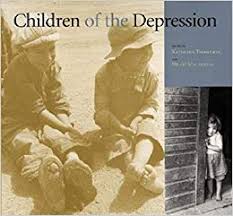Children of the Depression — in Photographs
Listen to the Recess! Clip
| Author | John Cech |
| Air Date | 5/27/2002 |

Children of the Depression Transcript
The facts are still staggering, as Kathleen Thompson and Hilary Mac Austin remind us in their new book, Children of the Depression. In 1933, they write, “34 million men women and children were entirely without income. That was 28 percent of the American people then.” At this same time, they continue, “a quarter of a million children were homeless . . . . at least one in five were hungry and without adequate clothing . . . [and] In some regions, especially coal-mining regions, as many as 90 percent of the children were malnourished.”
Thompson’s and Mac Austin’s book is a testament to what children suffered during this crisis in American cultural life, when the bottom fell out, especially for the poorest in our society. Thompson and Mac Austin have brought this powerful and moving chapter of the history of American childhood back to us through the dozens of photographs that they have collected here from the enormous archives of the Farm Security Administration, the FSA. During the 1930s, the FSA actively documented the plight of children as well as their parents, in rural and small-town America, through the photographs and field notes of a corps of remarkable photographers, including Marion Post Wolcott, Lewis Hine, John Vachon, and Dorothea Lang. Their heart-breaking photographs captured both the physical and emotional states of these beleagured children and their deplorable living and working conditions. The 1930s brought us our first child labor laws, which were finally passed not because of an overwhelming desire to protect children from the harshness and brutality of the workplace, but, rather to keep children from competing with adults for scarce menial jobs. And yet, in these photos, the children continued to work: dragging cotton sacks through the dusty fields, trying to drive a plow through an eroded pasture, harvesting cauliflower and peas, hawking newspapers in the rain. Here is where those myths about hardship were in fact born, the ones that have been passed down from the grandparents and great grandparents, who really did walk to school barefoot and who really wrote the First Lady, Eleanor Roosevelt, to ask her for any old soiled dresses that might fit a seventh grader who had to stay out of school because she had nothing but rags to wear. These are unforgettable and necessary photographs; they remind us just how fragile and how brave the smallest among us always are.